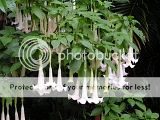Where did this passion come from?
It's hard to say how I became a gardener. My mom had a little garden in the front of the house, but I never helped with it. Once I moved out, I never had house plants nor did I pay a second glance to them when I saw them at other peoples homes.
In the Summer of 2000, I was pregnant with my second son and we bought our first house. It was just a little old rambler in an old neighborhood that needed some love. The people that owned it before us let their son use the front flower beds as sandboxes. They were small. There was one on each side of the door and they were very simply lined with old bricks half stuck into the ground. I must have felt very maternal or feminine, because I knew they could be much cuter than sandboxes – or dirt boxes.
I visited the local “big box” parking lot garden center a couple of times, trying to figure out what everything was and what I might possibly like, but I really had no idea. I did that a few times, but never bought anything. Finally, I lugged my big belly and swollen ankles back to the same little garden center with the mindset that I would just get whatever looked pretty, because I deserved flowers. I can't even remember what I picked out or how it looked. My mom brought over some orange day lillies and we put them in the back of the bed, just under my bedroom window, and that's all I remember. I'm sure it looked awful.
From there we moved a couple of times trying to find the perfect place to raise our two rapidly growing boys. We landed in what we thought was a small quaint town far enough out of the city to be a good place for a growing family. The house was old and had a lot of character. The yard was long, flat, and had no trees. After a full summer I decided it was time to try to garden again. I planted some Oriental Lillies under the Korean Lilac Tree. But I needed more. So I tilled a small garden in the very back of the lot. I planted some Daisies, some Dwarf Irises and a few other things I had never tried before. I wandered through the local nursery trying to figure out what I liked. I read plant tag after plant tag until I thought I had what I needed. I split some plants from my Day Care Lady, and before I knew it my small garden had spanned the length of the lot and was 40 feet wide all the way across. I added an arbor next to the shed, and a little path that led to a tiny patio with a bench.
I sat for hours looking at that garden. Observing what bloomed when, what did well where it was, what didn't. Hours and hours I sat. I moved plants around and learned how to split them. I wanted more. I subscribed to gardening magazines, bought books, and played on the internet researching plants and designs.
We decided after three years that it wasn't the perfect place that we thought it was. So, we ventured on to a much smaller town. I split and potted everything out of my garden that I could. I brought van load after van load of potted splits to our new home an hour a way. There was no garden for them. It was July and it was hot, but I had a plan, sort of.
The neighbor had his friend bring over his tractor tiller so that I could get my plants in the ground. I laid the hose out in a curvy shape stretching from the end of the small fenced arbor at the end of the front sidewalk. With my new neighbors, their friend and my husband all thinking that I was clinically insane, I had him till the exact shape as the hoses were laid. I plugged in what I had brought with me and hoped for the best.
That garden now stops people driving by on our quiet side of town. There's always something blooming and your eye is never bored. My neighbor started asking me to garden with her. In the three years that have passed since we've moved, I've also designed and added several more gardens on our half acre lot. Moving plants and adding pathways, expanding where I need more room. I collect seeds from annuals and split perennials, sharing whenever I can. I've gone as far as having our old rock basement lined with aquarium lights so that I can grow throughout the cold Minnesota winter.
So, how did the passion for gardening begin? I'm not sure. Sometimes you stumble upon things by accident and they become what you never knew you didn't have.














 Angel's Trumpet (Brugsmania)
Angel's Trumpet (Brugsmania)